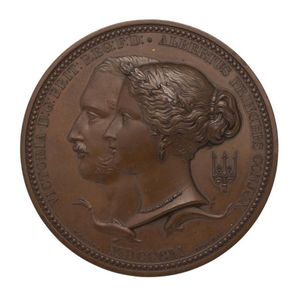1891 Bronze Medal for Local Art Exhibition & Display
You must be a subscriber, and be logged in to view price and dealer details.
Subscribe Now to view actual auction price for this item
When you subscribe, you have the option of setting the currency in which to display prices to $Au, $US, $NZ or Stg.
- Embossed / Repousse - Embossing, also known as repousse, is the technique of decorating metal with raised designs, by pressing or beating out the design from the reverse side of the object.It is the opposite of chasing, where the decoration is applied from the front. An embossed or repoussed object may have chasing applied to finish off the design.
- Bronze - An alloy of copper and tin, traditionally in the proportions of about 9 parts of copper to 1 part of tin.
The discovery of bronze in Western Asia in the 4th century enabled people to create metal objects which were superior to those previoulsy possible because of its strength and hardness, and it has been used throughout the world for weapons, coins, tools, statuary and other decorative items.
It is very fluid in a molten state, and its hardness, strength when set, and non-corrosive properties makes it most suitable for casting sculpture.
This item has been included into following indexes:
Visually similar items

Bronze medal (76 mm) by the Melbourne Mint - Stokes & Martin; impressed around edge 'T.H.McGowan Esq.'

Great Exhibition Prize Medal in original case of issue. Bronze, 64 mm, by W.Wyon/G.G.Adams, impressed around edge 'Prize Medal of the Exhibition. Davy, Mackmurdo & Co. Class II' Davy, Mackmurdo & Co. were manufacturing chemists & druggists in London.

Reception of Victor Emmanuel II, the King of Sardinia, At the Guildhall, London: 1855 bronze medal by Benjamin Wyon, 76 mm; Obv: Bust of King : Victorius Emmanuel II Rex Sardiniae in Londinium A Praeside Civibusque Receptus (Victor Emmanual II, King of Sar

Two copper medals by Gayrard for the Participation of France, Ministry of Agriculture and Trade. (51 mm, 62g) both in original cases in very good condition, with winner's names (Mr. A. Sege & Mr Dumax) embossed on the front of each case.
